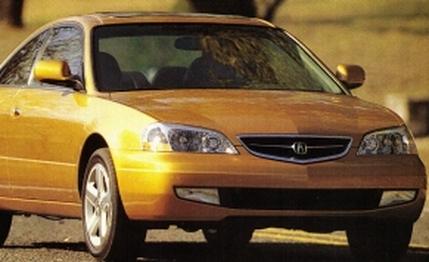
 First Drive Review
First Drive Review
Our last visit with the Acura CL came in the September 1999 issue, when we placed it in a head-to-head comparison with the Toyota Camry Solara SLE.
That Acura 3.0CL lost by a single point, as we complained --not loudly, but complained nonetheless --about the CL's less satisfying, less quiet ride, its cramped rear seat, and its jerky shifts under hard acceleration.
All that and then some are addressed for 2001, as Acura gives us an all-new CL, this time based on the Acura TL sedan, which is based on the current Honda Accord chassis instead of the last-generation Accord, as the 1999 CL was. (The CL took the 2000 model year off.)
And we certainly like the TL sedan, having given it a first-place finish in last month's nine-sedan comparo. So if we love the TL four-door, we oughtta really love the CL two-door, right?
Well, not quite yet. The 2001 3.2CL (gone, thankfully, is the four-cylinder version, the 2.3CL) feels a lot like the TL, meaning it's competent, quick, quiet, and comfortable. But a mild lack of personality - not quite sterility, but close -- that seems acceptable in a family sedan is less so in a sporty coupe. I mean, we aren't talking Dan Quayle here, or even Al Gore, but the Acura 3.2CL seems pretty mild-mannered.
That applies even to the 3.2CL Type S, surprising given the statistics. The Type S (considered by Acura to be too civilized to get a Type R designation, like the peaky but fun Integra model) has a 260-horsepower version of the 3.2-liter V-6, which pumps out a still-respectable 225 hp in both the 3.2CL and 3.2TL.
Those 35 extra ponies come mostly from a dual-stage induction system that uses a big twin-chamber intake plenum separated by a valve -- at 3800 rpm, a solenoid opens the valve, then pressure waves reflecting along the length of the intake runners produce a natural-resonance supercharging effect.
The Type S benefits from better exhaust flow, due to a bigger catalytic converter and higher-flow dual mufflers, and it gets domed pistons (upping the compression ratio from 9.8:1 in the base 3.2CL to 10.5:1), spin-cast cylinder-wall liners, different intake valves, and different camshafts. There is no penalty in drivability, and very little in fuel mileage -- the 3.2CL is EPA-rated at 19 mpg in the city and 29 mpg on the highway, and the Type S gets 18 and 28. Not bad, considering that the 200-hp '99 3.0CL got 20 and 28.
In either form, that 3.2-liter V-6 is among the smoothest you'll find. The VTEC valvetrain works seamlessly to maximize power at all speeds.
Both CL models get the TL's five-speed automatic transmission with Sequential SportShift, as sadly no manual is available or contemplated. Shift quality is far better than with the four-speed we complained about in the CL and Solara matchup. The Sequential SportShift feature makes the CL seem, well, sportier, but no more so than the TL in that respect.
Otherwise, what else is new? Quite a bit. Now that the CL resides on Acura's "global mid-size platform," the car grows a bit. The 106.9-inch wheelbase is retained, but the overall length is up two inches to 192. Width increases a half-inch to 70.6; height, from 54.7 inches to 55.5. The 3.2CL weighs about 300 more pounds than last year's model. The Type S is a smidge heavier, due mostly to the 17-inch tires and wheels replacing the base CL's 16-inchers and also to a bigger rear stabilizer bar and Vehicle Stability Assist, standard in the Type S. The optional navigation system adds about 15 pounds to either model.
Inside, better isolation pretty much eliminates the noise we complained about in the September comparo. Front-seat interior volume increases to 52 cubic feet, up from 51, and the rear gains four cubic feet for a 38-cubic-foot total. The front leather-trimmed bucket seats are quite good, and the rear seat, although still minimalist, seems a bit more hospitable.
Most of our limited time in the new CL was spent in the Type S, and it was pleasant time, indeed. Our hand-timed 0-to-60-mph runs fell in the neighborhood of about seven seconds, which is certainly quicker than the last 3.0CL we tested, which sprinted to 60 mph in 7.8 seconds. The Type S seemed oddly slow off the line, but midrange power was excellent. We expect a low-15-second time in the quarter-mile when we get our hands on a testable Type S.